The Haute Couture History of Sailor Moon
In Depth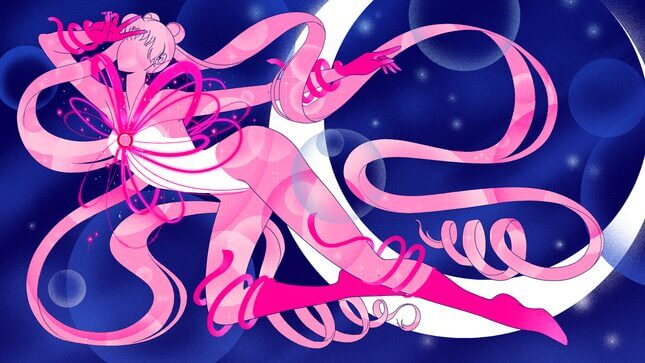
Illustration: Chelsea Beck
Christian Dior’s haute couture collection for the Spring/Summer 1992 season was not genre-defining per se. Named In Balmy Summer Breezes, it was “a very feminine collection, for a Parisian woman feeling the Parisian breeze, its colors and its flowers,” as the creative director Gianfranco Ferré told the Italian press. Florals for spring? I know, I know. Yet, among the suits, wide-brimmed hats, and cocktail dresses in floral hues (from lavender to sunset colors) was an evening gown in chiffon modeled after a Greek pillar, the “Palladium” dress. Its off-the-shoulder sleeves mirror the pillar’s volutes; the empire-waisted bodice reprises the egg-and-dart motif of the capital; the gown itself is a pleated sheath.
This dress, a tribute to both Greek architecture and to Pauline Bonaparte, made a substantial dent in pop-culture history in the following years. That’s because—as any child of the 1990s will easily recognize—it’s the dress worn by Princess and Neo Queen Serenity, the past (and future) self of Sailor Moon, the main character of the iconic show where a group of girls aged 14 to 17 fight increasingly dangerous forces that threaten the present, the past, and the future of humankind. The appearance of this dress was indicative of a major plot development or denouement: At the climax of each of the five seasons, Sailor Moon would discard her schoolgirl-inspired uniform in favor of her royal garb, through which she could unleash previously untapped power.
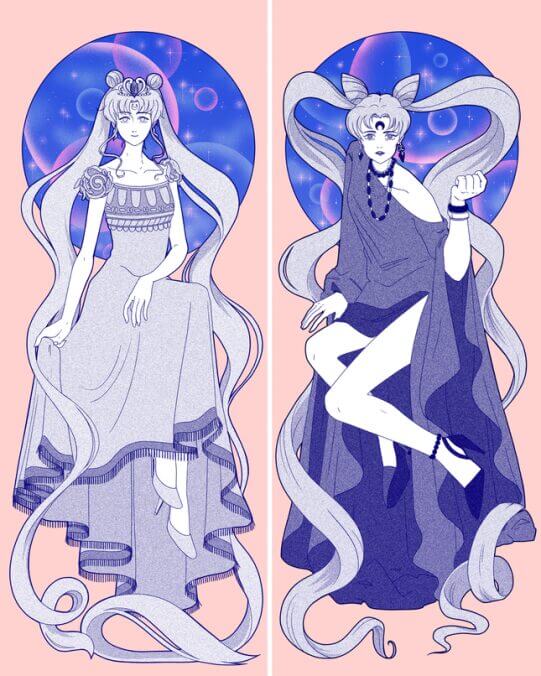
Fans praise Sailor Moon as a seminal work in 1990s manga and anime. It combined the more poised magical-girls anime genre popular from the ’50s onwards, where an ordinary preteen or teen is given a magic trinket that gives her a secret identity and a slightly more glamorous appearance, with later, mid-1970s onwards fighters such as the Power Rangers or the Zodiac-powered Saint Seiya. At the same time, it maintained a strong focus on friendships, the showcase of emotions, and delicate displays of queerness. Sailor Moon herself is not made of steel: fellow characters described her civilian self, Usagi, as lazy and as a crybaby, and her power as a sailor guardian relied more on her selflessness in pursuit of love, dreams, and justice (sic) than the standard move-set of a western superhero. It was a tale of empowerment unknown in the West.
SAILOR MOON IS AN EMINENT AND INFLUENTIAL WORK OF VISUAL ART
But the art of Sailor Moon is as interesting as its plot and characters. For the 25th anniversary of the show’s American debut, it’s time to recognize the show as more than classic ’90s girl-power fare; it’s an eminent and influential work of visual art. It is a foray into haute couture and fin-de-siècle art, and author Naoko Takeuchi disseminated high-brow references across her comic, anime adaptation, cover art, gadgets, and artbooks. The art style is both simple and direct, as it hinges on markers that make characters instantly recognizable and appealing to children (schoolgirl uniforms, unique hairstyles, bold colors), and is also the result of in-depth research in fashion and art history, which rewards the older audience members who know what to look for.
The Dior-like Princess Serenity dress is the most eminent example, and it’s not just a fashion statement—even though once she upgraded from princess to queen, the dress also got a wing-like cascading ribbon in the back, inspired by couturier Roberto Capucci’s Angelo d’oro dress, featured at the 2018 Met exhibition Heavenly Bodies. Serenity’s dress, in its shape and its color, is a symbol of spiritual power. “Any figure that wears white in Japanese is somehow a liminal figure—one who stands both in the real world and the world beyond. Brides cross from one family to the other; corpses (and ghosts) cross from one life to the next; priestesses initially became part of Shinto and Buddhist practice as mediums and hosts during exorcisms in the Heian period,” Dr. Emerald King, who studies costume representation in anime and manga, told me over email. “In the west, we’ve come to think of white as a kind of purity from our Victorian ancestors, but white is a much more powerful symbol. In Japanese colours, the binary isn’t black and white, but white and red.”
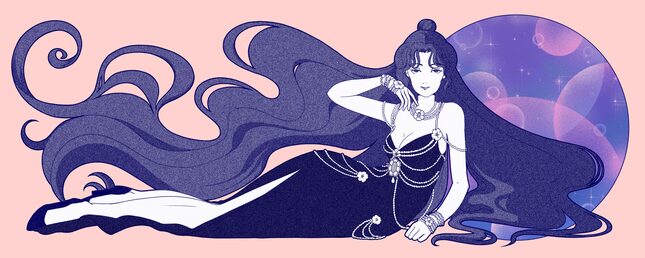
The other sailor guardians, drawn to resemble girls aged 14-17, tended to wear more “normal” ’90s dresses, but Sailor Pluto—the more somber and mature guardian of time—was an exception. In the Pretty Soldier Sailor Moon Original Picture Collection Vol. III, for example, she was made to don a Spring/Summer 1992 Chanel Couture dress, a black form-fitting silk crepe sheath draped with gold chains. Naomi Campbell and Christy Turlington modeled it in 1992; Penelope Cruz wore it in 2009 and Lily-Rose Depp sported it at the 2019 Met Gala, whose theme was Notes on Camp. “Setsuna-sama’s clothes are something supermodel Naomi Campbell wore. I love supermodels,” Naoko Takeuchi wrote in the marginalia for her Sailor Moon Original Picture Collection Vol III Artbook.
But Sailor Moon fully dives into the history of fashion with its femme and androgynous villains, who wore mermaid gowns, bodycon dresses, high-cut leotards, tutus, and armored breastplates. Usually, it was medium-grade villains in the early seasons who were bestowed that honor: A Lacroix outfit from the Fall/Winter ’92/’93 collection, for example, was the inspiration behind the breastplate bodice, statement necklace, and hair ribbon of the character Calaveras. The maroon-and-purple gown worn by Kate Moss for her 1994 Opium ad is the basis of Black Lady’s outfit.
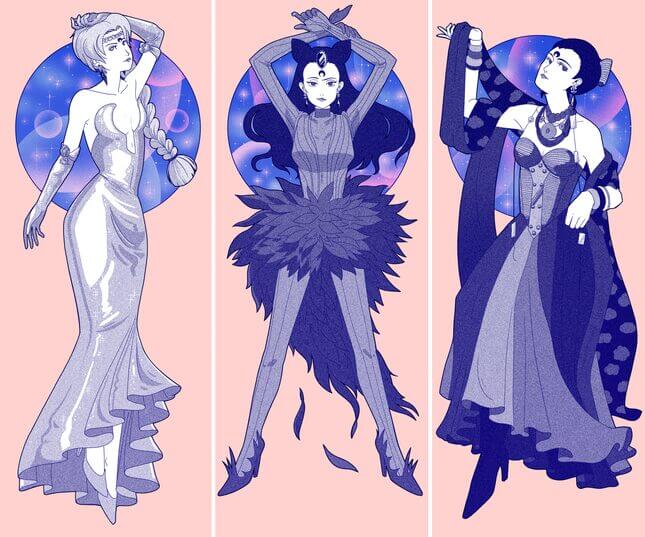
But the main inspiration behind glamorous villainesses was the avant-garde couturier Thierry Mugler. A multi-layered tutu skirt worn over a semi-sheer catsuit from his debut collection (F/W 1992), coupled with an elaborate hairdo, was the inspiration for the villain Koan, while a shimmery, light-blue mermaid gown with matching opera gloves (A/W 1992) was turned into a bodysuit for the villain Berthier. As the series progressed and Takeuchi leaned more into glam-rock unitards and stage costumes for her characters, Mugler’s influence remained. His S/S 1997 couture collection was partially inspired by Kafka’s Metamorphosis, and the grand finale had a model wear a (relatively) pared-down outfit with a pair of outsized, brightly colored butterfly wings, and the minor villain Sailor Heavy Metal Papillon (manga only) wears a similar outfit. The arch-villainess sailor Galaxia, with her golden cuffs, golden armor-like bodice, and golden high-heeled boots does not stray too far from Mugler’s famous gold-metal corset: First seen in 1995, it was then retooled for Beyoncé’s 2009 world tour.
Why did villains get a fashion treatment that the heroines were, mostly, denied? Efficiency. “The reason Takeuchi can go to extremes with the villains, more so than the guardians themselves has to do with age, but also the mechanics of manga/anime design,” said King. “Often, characters who are drawn lots will have simplified versions/depictions of their dresses for ease of replication. One hallmark of shojo manga are fashion-plate-like full-page spreads of garments. These introduce a new outfit and allow it then to be depicted in a short-hand form in subsequent pages, giving the artists a bit of a break.”
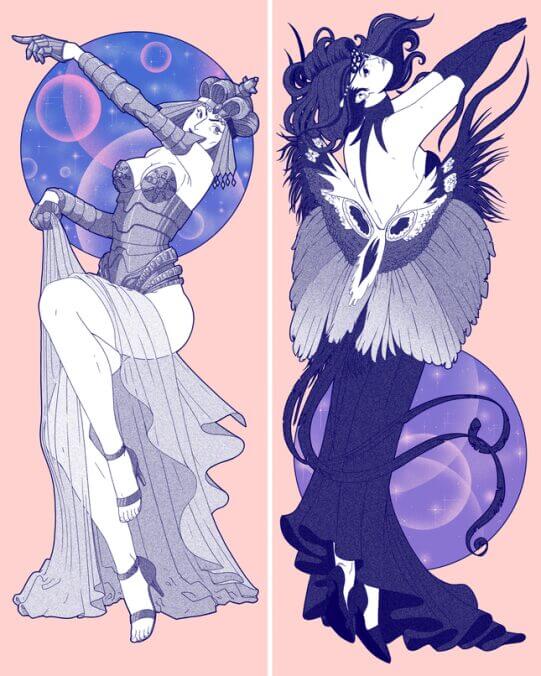
Sailor Moon also contains several references to art history. Specifically, Naoko Takeuchi was quite fond of art-nouveau artist Alphonse Mucha, who enjoyed widespread popularity among manga artists for the way his line-work and minute details fit within the geometric and curvilinear frames of his compositions, which naturally complemented the style adopted by shojo manga authors. “I drew this picture on green paper. Sailor Moon’s outline is in pencil. I wanted to do a picture in the style of the Czech artist popular among shoujo manga artists, Mucha,” wrote Naoko Takeuchi in reference to a close-up of Sailor Moon, inspired by Mucha’s Etoile du Matin. An off-the-shoulder flowy gown with elaborate embroidery on the bodice that Sailor Moon wears while being kidnapped by a villain who is obsessively in love with Neo Queen Serenity is modeled on Mucha’s famous “Reverie.” There is also an entire card set modeled on Mucha’s series The Times of Day [Evening Contemplation] (1899) and The Precious Stones [Topaz, Amethyst, Ruby, Emerald] (1900).
When Takeuchi conceptualized the spin-off movie The Lover of Snow Princess Kaguya, where a snow queen from outer space attacks the planet, she drew from art nouveau and art deco again, inspired by an antique-buying spree. “The model for Snow Kaguya in ‘The Lover of Princess Kaguya’s’ is an Art Deco ornamental piece called Salomé,” Takeuchi wrote in the marginalia of the 11th volume of the manga, which contains a version of the same story. “She is indeed made from cold, delicious-seeming milk-colored (with just a hint of blue) glass. I came up with the story by putting this “Salomé” on my desk and gazing at her all day long.” As for Kaguya’s minions, the snow dancers, they were inspired by delightful statuettes from the 1920s known as “Tänzerin” (dancer) by Theo Voss, a series of porcelain statues depicting a dancer twirling in the style of avant-garde dance styles —wearing a tunic-like costume and performing a semblance of very geometric movements—rather than ballet. This is pretty impressive for a product devised as mass entertainment for kids and teens.
Artistically speaking, the magical-girl genre didn’t plateau with Sailor Moon: Magic Knight Rayearth and Card Captor Sakura by Clamp have a more elaborate art style and cogent storytelling; Mermaid Melody combined monster-fighting with mermaids and pop-idols; Puella Magi Madoka Magica looked inward into the genre, exploring the mental and physical burden said magical girls shoulder.
Yet, Sailor Moon is a more timeless work. Tables have turned and, in the fashion industry, both Nicholas Ghesquière and Mugler himself paid tribute to the work, the former through the use of tiaras for their SS 2016 collection, the latter with Lady Gaga as a deconstructed and avant-garde princess Serenity in 2011.
“It became a central part of most people’s anime-watching experience: every cosplayer, regardless of their gender, will at some point do a Sailor Moon costume,” said Dr. King. This is true for art inspiration too. “I think the reason why Sailor Moon became such a drawcard is that, for an anime, she’s relatively easy to draw and make her look recognizable: a smiley face; long pigtails and a moon,” she said. “The fact that you have a whole host of characters who are the same but different means that there is a character for everyone to relate to, even if it’s not [the main character] Usagi/Serenity.”
And, by reclaiming haute couture pieces for her original characters and making them so iconic some people don’t even know they were originally haute-couture looks in the first place, the author Naoko Takeuchi presented us with an unprecedented vision of the superhero(ine) genre, making it a real work of visual art with enduring appeal beyond its plot and unforgettable characters.
Angelica Frey is a writer and a translator. No form of visual arts is beneath her curiosity, and her work has appeared in places including The Cut, The Guardian, Artsy, Hyperallergic, Garage, Art and Object, and AirMail; read her work at www.angelicafrey.com.